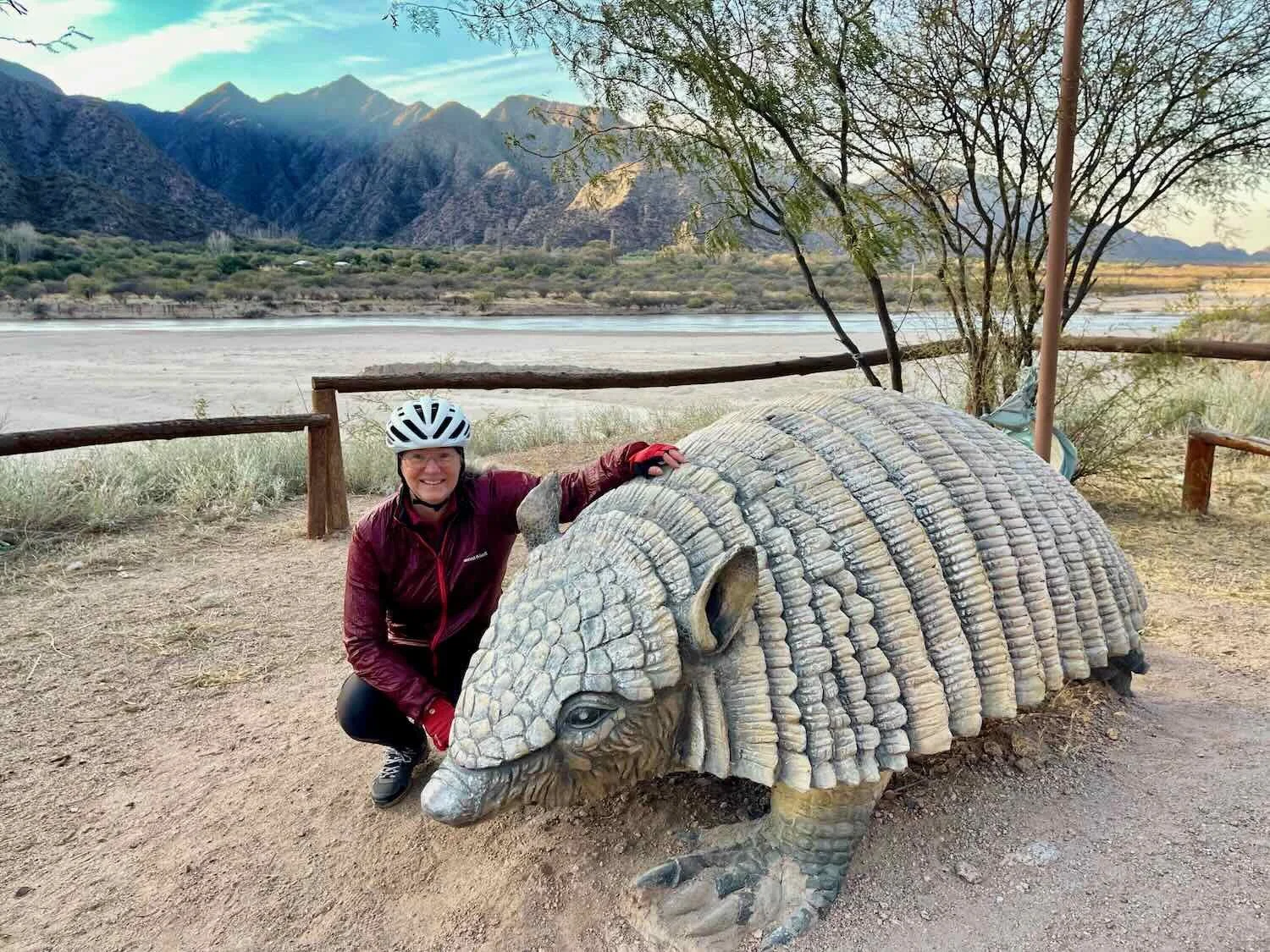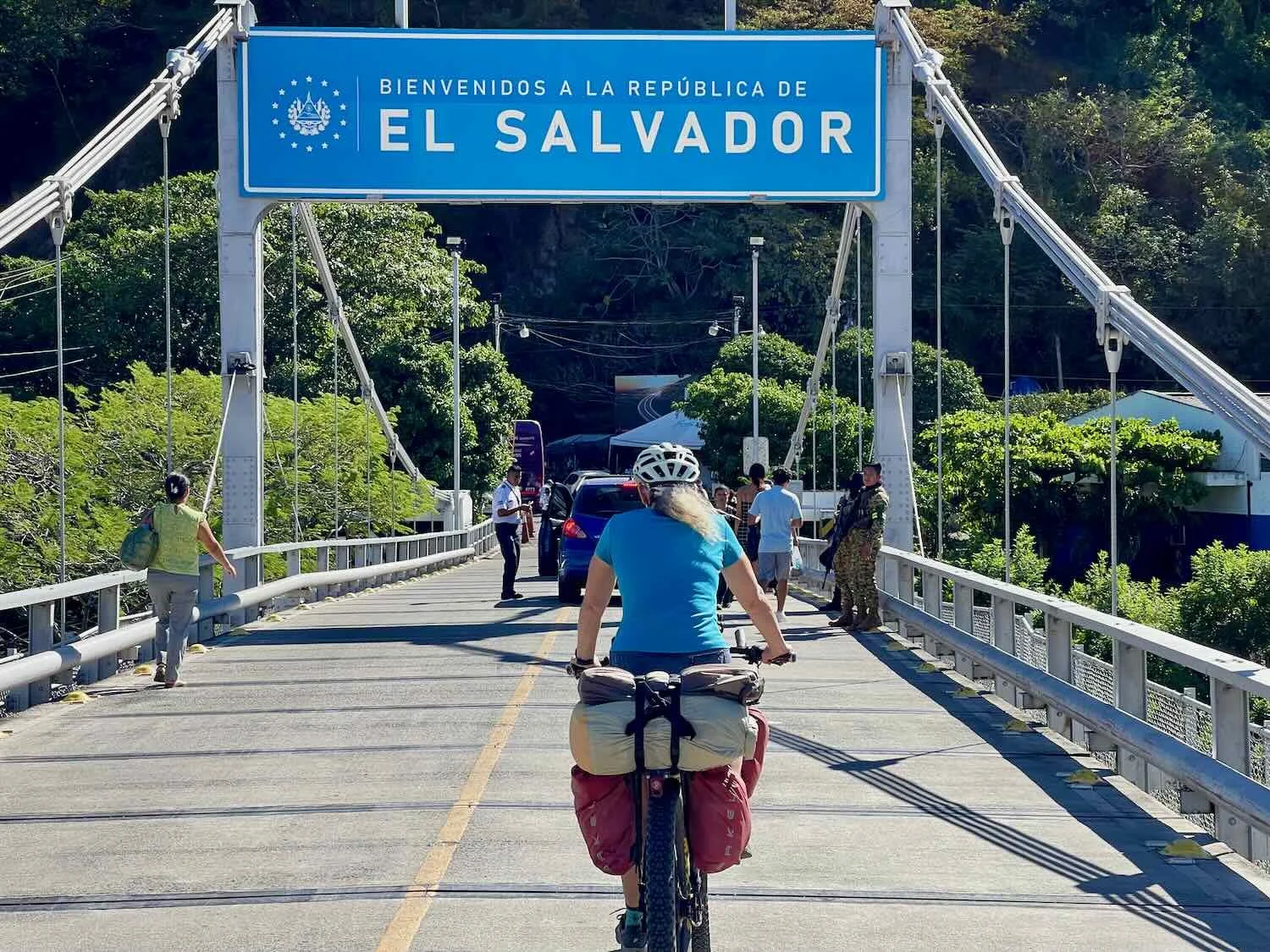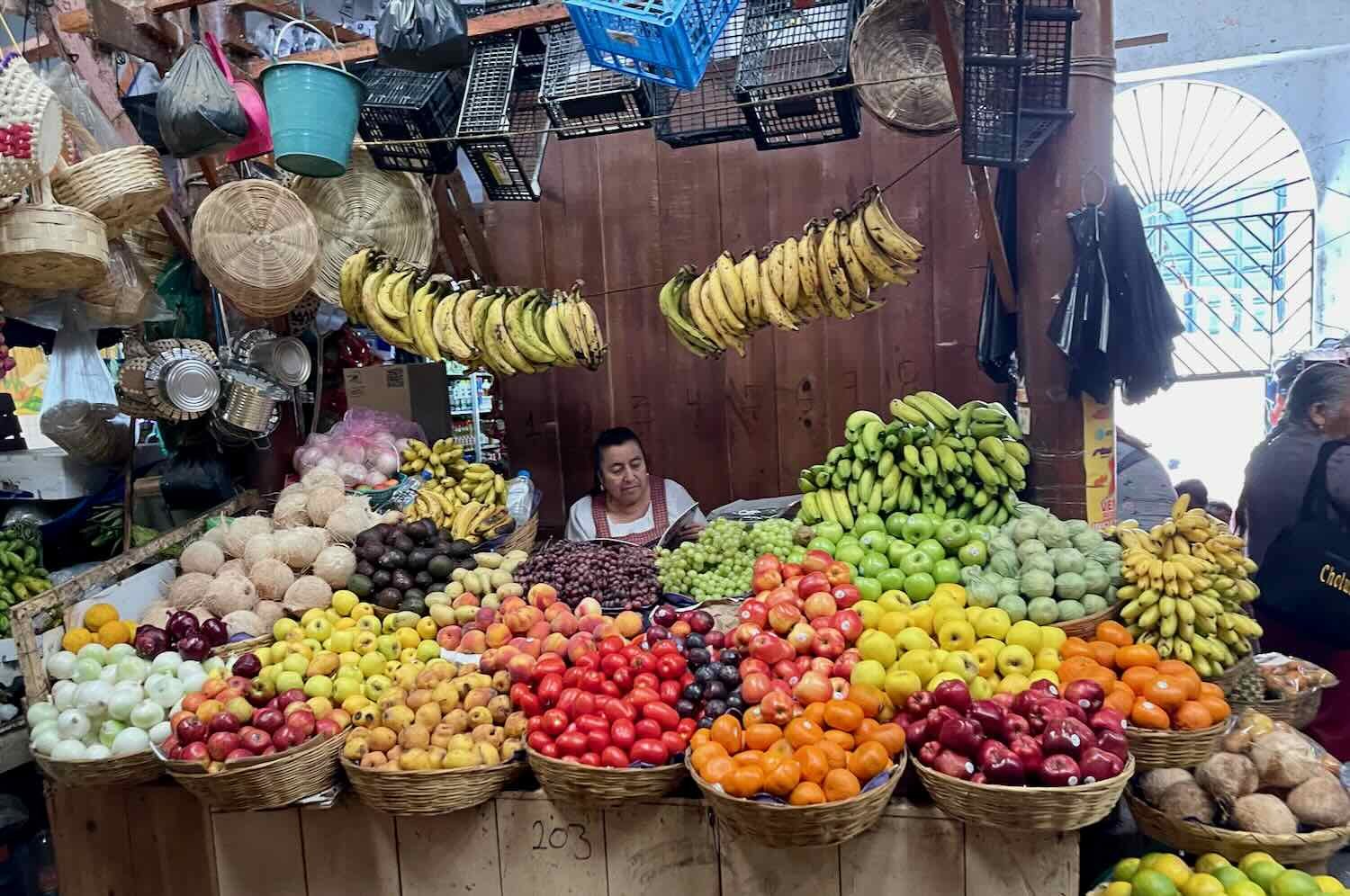Cycling the Altiplano Near Lake Titicaca: La Paz (Bolivia) to Puno (Peru)
After cable cars magically lifted our bicycles and us up and out of the deep valley of La Paz, we cycled back onto the open grasslands of the altiplano. Soon we were cruising along the shore of the enormous, high-altitude Lake Titicaca - the mythical birthplace of the Sun and the Moon. We then said ‘goodbye’ to Bolivia, and ‘hello’ to Peru, the other country that shares the legendary Lake Titicaca.
Cycling Argentina’s Route 40, Part 4: Chilecito to Salta
North of Chilecito, the landscape burst into a complex maze of ridges and high deserts. Cycling along ancient paths among the sierras, we followed Route 40 across arid valleys, over high, cold plateaus, and through narrow canyons lined with stunning rock formations. Tranquil desert camps alternated with humble, village hospedajes. Eventually we descended into greener lowlands, cycling into the historic and charming city of Salta.
Cycling Colombia Part 4: Ibagué to Neiva
It was time for us to leave the high mountains, at least for a little while. A rapid descent from the Central Andean Ridge landed us in the fertile Magdalena Valley. Over the next week we cycled through Colombia’s heartland, bordered by the distant, blue-gray ridges of the Andes that rise nearly three miles into the sky. We crossed a wide, rushing river to reach Colombia’s largest inland desert, where we lost ourselves among strange, ghostly shapes. Then a final, quiet bike ride through the countryside brought us back to the shores of the fabled Magdalena River, among monuments to some the region’s strange, mythical inhabitants.
Cycling Colombia Part 3: Medellín to Ibagué
We departed Medellín in the company of a couple of hundred other cyclists, all climbing a big mountain on a Sunday just for fun. The descent brought us into Colombia’s coffee heartland, but we still had to cycle up and over the Central Andes. We climbed up to a picturesque mountain town, and then over the 11,083 ft (3,378 m) Alto de La Línea pass - one of the highest in the country - where forests of wax palms (Colombia’s national tree) grow among the clouds. From there we dropped back down to the Music Capital of Colombia, and spent a couple of weeks enjoying the Colombian National Folk Festival, where groups from all over the country come to celebrate their cultural heritage.
Cycling Across Panama: The Road to the Panama Canal
Panama stands at the crossroads of two continents. At its narrowest, just 30 miles of land (48 km) separates the world’s largest oceans. Here, where the Pacific and the Atlantic Oceans nearly meet, the Panama Canal bridges the gap and creates one of the most important international waterways in the world. In addition to the canal, Panama’s vibrant traditional, indigenous fabrics formed the backdrop for festivals celebrating the Lunar New Year (Asian) and Holy Week/Easter (Catholic) holidays, reinforcing Panama’s distinction as a ‘melting pot’ of cultures. Our road ended in cosmopolitan Panama City, where on any given day we could visit a historical old town, a scenic Pacific waterfront, or a nearby tropical forest. It was a wonderful ‘adios’ to our journey across North and Central America. South America, here we come!
Cycling Honduras and Nicaragua: The Flat Pacific Lowlands
Central America has many countries crowded into a relatively small space, leading to frequent encounters with immigration offices. Having crossed quite a few land borders over the years, we nonetheless wondered if we were up to the challenge of Honduras and Nicaragua. Both have a reputation of bringing even the most seasoned travelers to their knees with less than well oiled bureaucracies. Luckily, we successfully maneuvered the bureaucratic obstacle courses at the borders. A home run in getting a visa extension in Nicaragua gave us the time to enjoy the capital city of Managua, and soak up the wonderful, historic ambiance of Granada, on the shores of a freshwater lake inhabited by sharks.
Cycling across Guatemala and El Salvador
From Guatemala City we had only three days of riding to the border with El Salvador. Yet Guatemala continued to enchant us, with pre-Christmas festivities in one town and a colorful saint’s day procession in another. After a difficult border crossing, we once again marveled at the differences between countries as El Salvador revealed its own, unique character and beauty - even though our holiday plans in San Salvador didn’t quite work out as planned.
Cycling Across Guatemala: In the Land of Volcanos
After the big climb out of Lake Atitlan’s ancient crater, we cycled through more of the Guatemalan Highlands. In the historic city of Antigua, we soaked up the interesting mix of Mayan and Spanish influences before climbing a volcano. A final push took us to Guatemala City, where we celebrated the approaching Christmas holiday as we worked on bike repairs.
The Most Beautiful Lake in the World: Cycling Huehuetenango to Lake Atitlán, Guatemala
As we continued our cycling journey through the Guatemalan Highlands, each community we passed though had its own, unique character. Giant kites fluttered in the wind over a mountain town churning out colorful textiles. Mayan ritual sites clustered in a new-age enclave where music filled the air. And international cuisine was served in a town where most people’s native language was Mayan. But the main attraction was the breathtakingly picturesque Lake Atitlán, with its backdrop of three volcanos - where a pre-dawn hike led us to a quetzal, Guatemala’s national symbol.
Cycling the Guatemalan Highlands: Cuatro Caminos to Huehuetenango, Guatemala
Over the course of three days we would gain nearly 10,000 ft (3,050 m) in elevation as we cycled upwards into the Guatemalan Highlands. This rural and rugged region is home to the Mam Mayans, who maintain many customs that date back hundreds of years, including wearing their traditional, woven and embroidered garments. We were fortunate to pass through one town during their lively, annual Heritage Fair. From there we plunged out of the highlands into the big city of Huehue, in time for the celebration of All Souls Day among the tombs in the municipal cemetery.
Cycling Into Guatemala: San Cristóbal de las Casas, Mexico to Cuatro Caminos, Guatemala
We wanted to savor our final few days in Mexico. So instead of heading straight for the border, we lingered in one more magical town and cycled through a countryside dotted with picturesque lakes. We finally said “good-bye” to Mexico at a little-used border crossing at the top of a really big hill. During our first couple of days in Guatemala we cycled along a quiet road lined with scenic rock formations - until we took refuge from the rain in a woodland bungalow, at a quirky and off-the-beaten-path recreational park.
Cycling the Chiapas Highlands: Arriaga to San Cristóbal de las Casas, Mexico
Departing Arriaga, Mexico we had nowhere to go but up. First, we cycled upwards from the hot and humid coastal plain through the gorgeous Sierra Madre del Sur, where a close encounter with wild coatis boosted our spirits. Next we crossed a broad, highland valley that took us to the state’s bustling capital city. But it was the second big climb, up onto the high Chiapas Plateau that nearly did us in. After gaining a mile and a half in elevation in a single day, we cycled into the magical town of San Cristóbal de las Casas - exhausted but victorious. San Cristóbal ended up being a wonderful place to hang out, becoming one of our favorite cities in Mexico.
Mezcal Mountains and Windy Lowlands: Cycling from Oaxaca to Arriaga, Mexico
After a wonderful layover in Oaxaca, we saddled up and cycled down the Pan-American Highway towards Guatemala. The road took us eastward through the heartland of mezcal production, then over a series of high mountain passes. After descending onto the Pacific coastal plain, we battled both the fierce winds that blow across the narrowest part of Mexico and a mysterious animal we found in our hotel room in the middle of the night. Our final stop was the bustling commercial hub of Arriaga, where we rested before tackling the big climb back into the Sierras.
TransMexico Norte Part 6: Cycling from Izúcar de Matamoros to Oaxaca, Mexico
The final leg of the TransMexico Norte bikepacking route took us across high ridges in the Sierra Madre del Sur. Daily thunderstorms ensured that we started our days early, and sought shelter in the afternoons. We traveled through the cradle of the Mixtec civilization, whose people have inhabited the high mountain valleys for thousands of years - and whose descendants remain to this day. On the final day of cycling, we dropped down into the Valley of Oaxaca for an extended layover, where we celebrated Mexico’s Independence Day.
TransMexico Norte Part 5: Cycling from Toluca to Izúcar de Matamoros, Mexico
After a break of nearly two months, we were finally back on the TransMexico Norte bikepacking route. We had spent much of the rainy season off our bikes, exploring Belize and Mexico City. But with a new, shorter deadline for cycling to the Guatemalan border, we had to get back on the road - even if it meant dealing with daily tropical downpours. Before long we had descended out of the high plains into lowland mountains shrouded in lush forests. Once again we discovered the pleasures of cycling through novel landscapes, and uncovering the hidden gems - like massive caves and offbeat museums - that other tourists rarely see.
TransMexico Norte Part 4: Cycling from Guanajuato to Toluca, Mexico
From Guanajuato, the TransMexico Norte bikepacking route took us into the country’s central volcanic belt, passing between two majestic volcanos and through two of the country’s most popular tourist towns. Along the way, we cycled among the steep-sided foothills of towering cinder cones, as well as through fertile lowlands of sugar cane and agave. Ubiquitous, colorful murals proclaimed Mexico’s love for Monarch butterflies, which overwinter each year among the pines on the slopes of a few, high, volcanic peaks. Just as the rainy season began in earnest, we reached the city of Toluca, where we would take some time off our bikes to let the rains pass.
TransMexico Norte Part 3: Cycling from Zacactecas to Guanajuato, Mexico
The sweet fragrance of a guava candy factory, or the scent of tanned hides from a long line of leather shops. The heat of the sun from a cloudless sky, or a cool breeze blowing across desolate hills. The sound of church bells, or a roving band of mariachis singing songs of love and loss. And the beauty of a mountain overlook, or a tranquil plaza in a colonial village. Traveling this part of the TransMexico Norte bikepacking route has served up a feast for the senses - anchored on each end by two of Mexico’s fabled silver cities, which at one time generated most of the wealth in the world.
TransMexico Norte Part 2: Cycling from Durango to Zacatecas, Mexico
The TransMexico Norte bikepacking route hugs the foothills of the Sierra Madre mountains on its way from Durango to Zacatecas. As we followed the route, we found ourselves alternately climbing up into the cool, pine-cloaked mountains, then plunging back down onto Mexico’s hot, arid, central plateau. There, at the edge of the desert, we cycled between bustling cities and magical towns that trace their histories to the Spanish empire’s hunger for silver and gold.
TransMexico Norte Part 1: Cycling from Mazatlan to Durango, Mexico
Saying farewell to Baja, we voyaged across the Sea of Cortez to mainland Mexico. From there, an arduous but spectacular 9,000 ft ascent (2,750 m) would take us from the coast to the heights of Mexico’s Sierra Madre mountains. Along the way we officially crossed into the tropics and rode through grand, colonial-era towns built on the mining of silver and gold.
Baja Divide Part 6: Cycling from Ciudad Constitución to La Paz
The final segment of the Baja Divide bikepacking route is the longest. For 170+ miles (275 km) it makes one final crossing of the Sierra La Giganta Mountains, then follows the stunning coast of the Sea of Cortez to the region’s capital in La Paz. On the first day we visited another one of Baja’s historic missions in the mountains. After lingering briefly in the cool, tranquil church and a pleasant lunch in the shade of a palapa, we cycled back out into the scorching, thorny, rocky and sandy backcountry. A tough road over the mountains, made a bit harder by a rooster-induced lack of sleep, brought us to the idyllic beaches of San Evaristo. There, an abundance of seafood tacos restored our energy. We spent our final night on the Baja Divide at one of the most beautiful campsites we’d ever had, next to a green stone cliff on a completely secluded beach. Seven days after departing Ciudad Constitución, we cycled into La Paz, buoyed by the memories of our incredible Baja journey, and ready to head to Mexico’s mainland for more adventure.



















